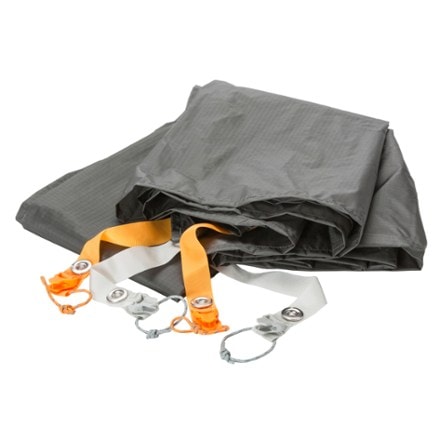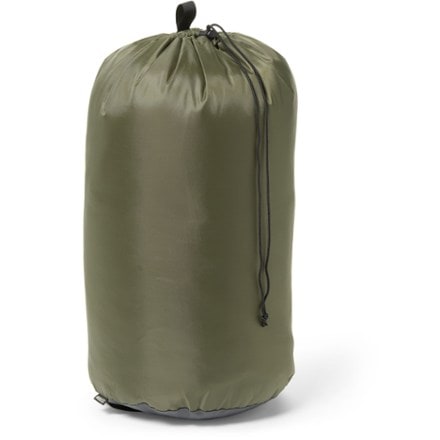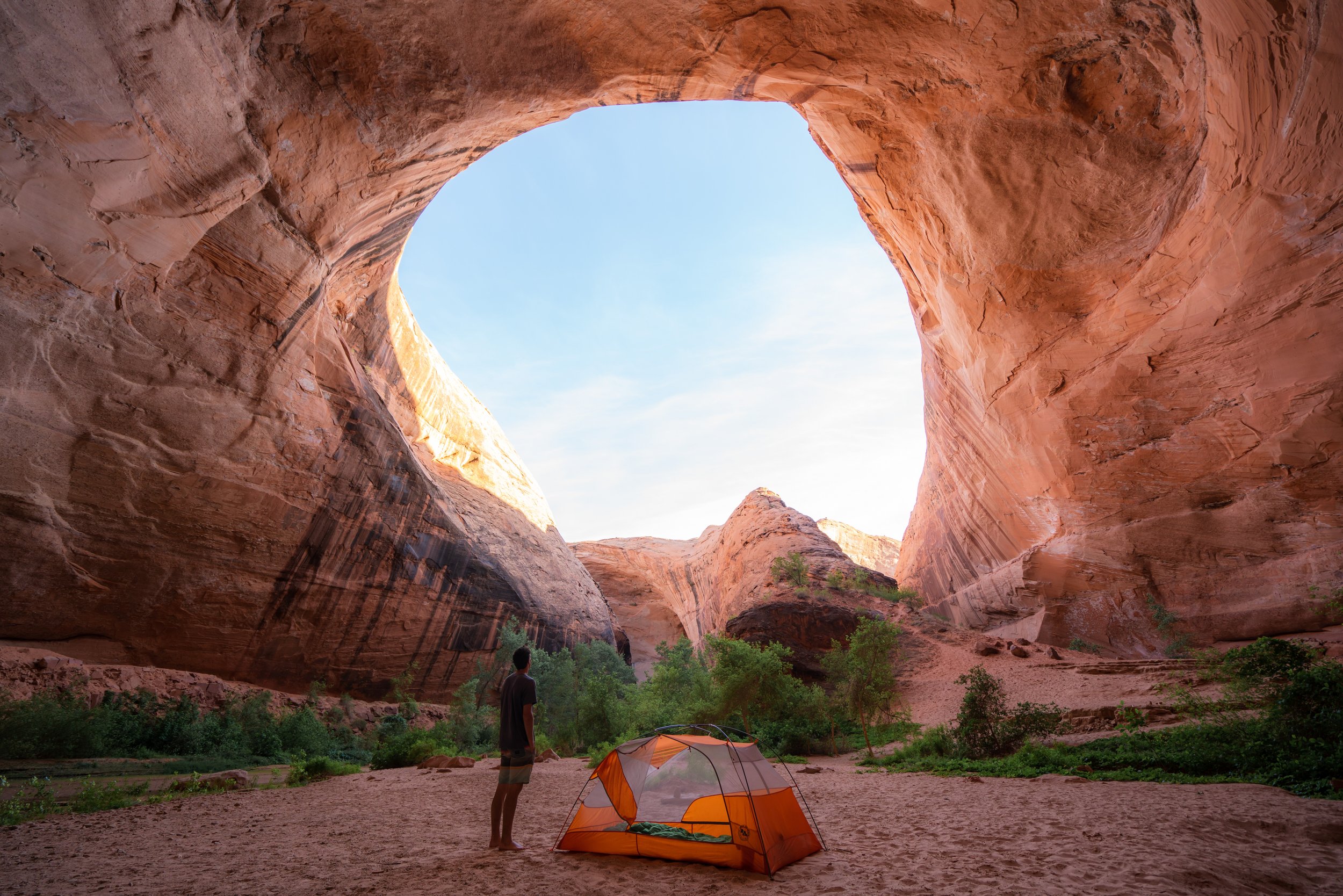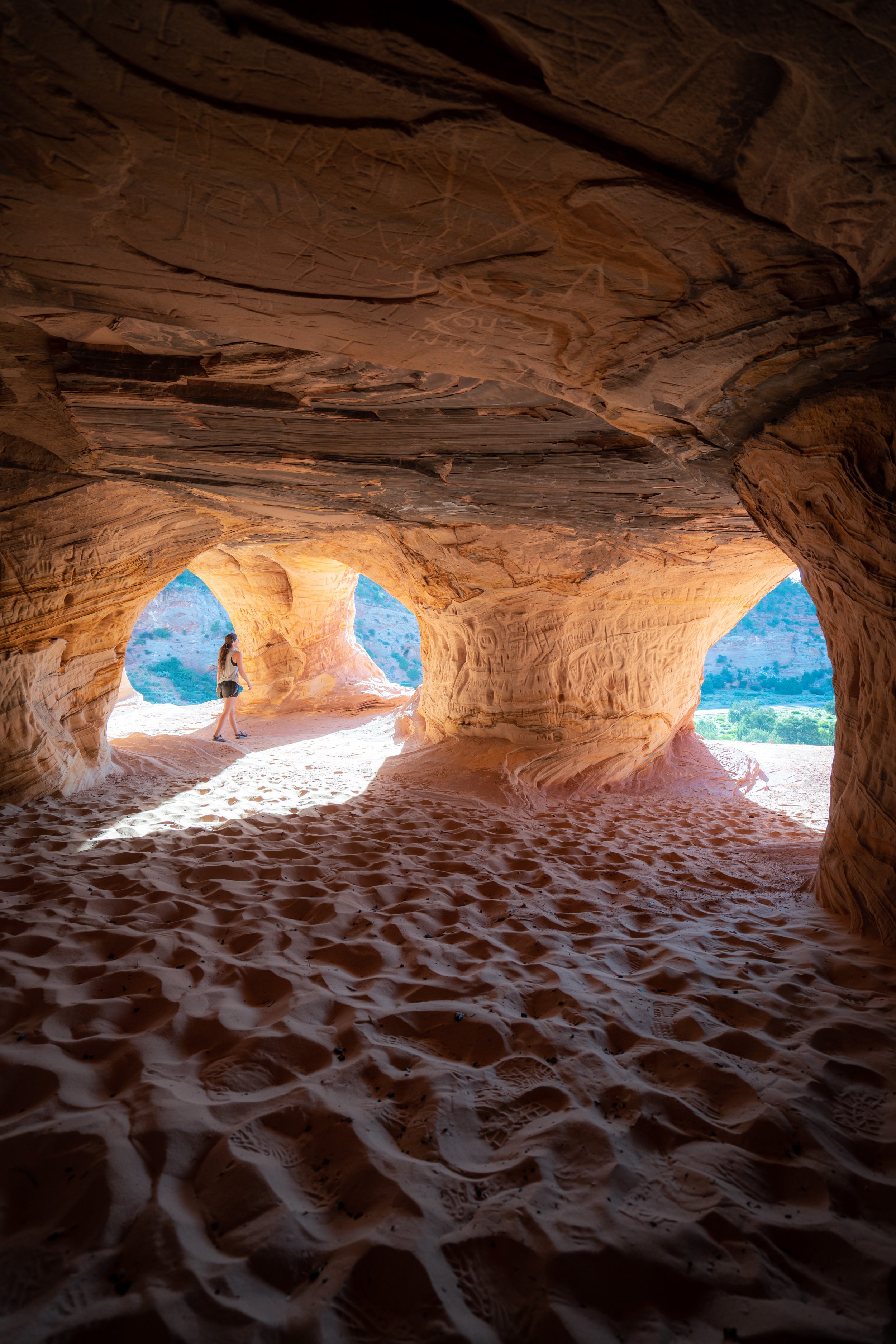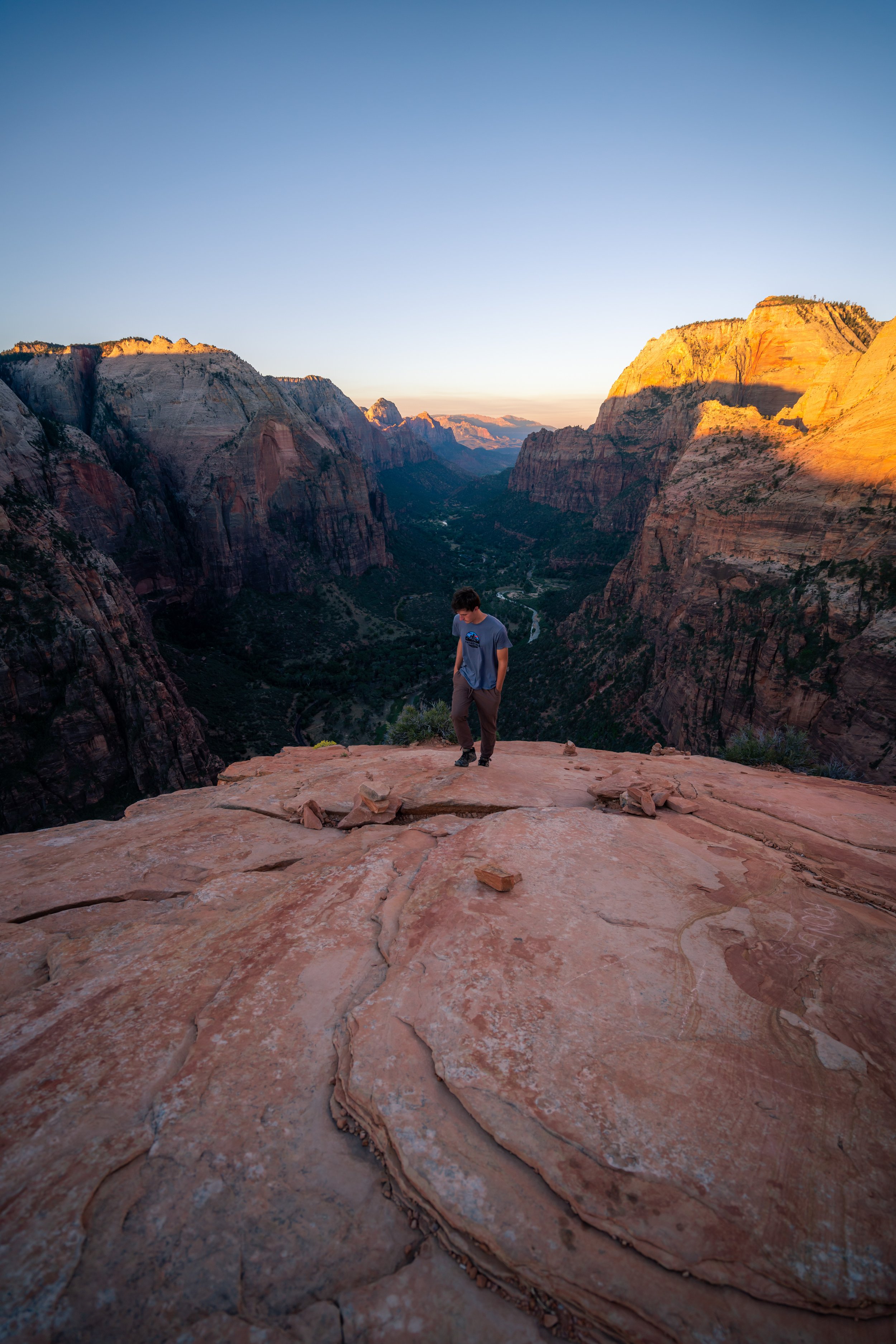Hiking the Havasupai Trail to Havasu Falls in Arizona: How to Get Permits?
Distance (Roundtrip to Campground): 19.4 miles / 31.2 km
Elevation Change: ~2,500 ft. / 762 m
The Havasupai Trail in the southern portion of the Grand Canyon is one of the most beautiful hikes in Arizona, and it’s a backpacking trip that I regard as one of my favorite hikes I’ve ever done!
That being said, the Havasupai Trail, the reservations, the campground, and all that is associated with the adventure is one of the most exclusive hikes in the U.S. because of how challenging it is to secure a permit, or at the least, secure a permit during one of the warmer times of the year.
Nevertheless, I’ve hiked into Havasupai numerous times, which is why I wanted to share everything I know about the adventure, including the best strategy to secure one of these elusive reservations!
How to Get Havasupai Permits?
The Havasupai Trail is managed by the Havasupai Tribe, not the National Park Service.
Beginning in 2024, the Havasupai Tribe implemented an advanced lottery reservation system, much like lotteries for popular federally-managed destinations on Recreation.gov, such as Mt. Whitney and The Enchantments Traverse.
That said, there are some need-to-know dates you must be aware of in order to participate. These can be found on the official booking website linked below, which is updated shortly before the start of the lottery each year in December. Then, lottery announcements are sent out to successful applicants shortly after it closes. This season, that date is January 6, 2025.
Regarding all unsuccessful lottery applicants, there is still the opportunity to claim leftover reservations, as well as unpaid lottery reservations, which the Havasupai Tribe releases to the general public at 8:00 a.m. PST on February 1st.
Considering these options, the Havasupai Tribe has said that interested visitors have the best opportunity to secure a reservation during the presale, which helps us all avoid the issues of the past, where permits for the 2018 season were completely sold out in less than an hour, and permits for 2019 took around two hours—both due to the website continuously crashing—meaning they otherwise would have sold out in less than a minute.
Book Here: Official Havasupai Reservations
What is the Best Strategy to Book Havasupai Permits?
The best advice I can give is to enter the advanced lottery and not have specific dates in mind—especially holidays or long weekends. Rather, it’s best to have a range of about 2-3 weeks that you’d be okay with, because specific dates, especially holidays, are never a guarantee. In all of my experiences, I never got the exact dates I wanted.
If you are successful with the advanced lottery, don’t forget to pay for your permit before the required date! This season, that date is January 24, 2025, at 5:00 p.m. PST.
Now, if you are unsuccessful during the presale, the best case scenario is to have everyone in your party logged in and ready to book at 8:00 a.m. PST on February 1st.
Then, when 8 a.m. PST hits, refresh the website, and don’t be alarmed if the website crashes immediately. The traffic demand can be insane! However, at least with the advanced reservation system, some of the traffic that would otherwise be on the site will be alleviated.
This is all to say that it has always been a struggle to get Havasupai permits—especially for a big group. However, there are little tricks that may help, including booking individually rather than as a big group, using a phone instead of a desktop, and trying different browsers.
With all this in mind, the experience will likely be different for everyone.
Best of luck! ᨒ 🤘🏼
Hualapai Hilltop Trailhead Parking
Parking for the Havasupai Trailhead is located at the Hualapai Hilltop, where the parking lot will most likely be full and crowded with hikers during the busy summer backpacking season.
What I mean by this is that every night, there are people sleeping in their cars and tents, waiting for their permitted time to begin hiking.
With this in mind, I highly recommended that you don’t drive a large RV, trailer, or any other vehicle similar in size. Parking at the Hualapai Hilltop is already hard enough as it is, and you will only be making it more difficult on yourself and other hikers by doing so.
Havasupai Security Checkpoint
As of 2019, a security checkpoint was implemented 4 miles (6.4 km) before the trailhead to check that hikers are arriving with valid reservations. Therefore, you need to make sure you have access to your reservation, whether on your phone or printed. There is also no cell phone service in this area, so come prepared.
In addition to the reservation check, the Havasupai Tribe has list of contraband, largely because irresponsible hikers in the past have brought down items that they don’t hike out with. This list includes items such as drones, coolers, alcohol, etc., and they will check your car, so good luck hiding a cooler.
Driving from I-40 to the Hualapai Hilltop
In order to avoid the worst of the summer heat on the trail, it’s very likely that you will begin the Havasupai Trail in the night, meaning that the drive to the trailhead will also be in the dark.
I bring this up because the road from Historic Route 66 is 60 miles (96.6 km) one way, which is in addition to which ever way you get there off of Interstate 40.
This is important to mention because there will be elk and cattle scattered alongside and on this drive, and you cannot count on cell phone service if you were to get into an accident.
Google Maps Directions: Hualapai Hilltop
Southwest Hiking Checklist
Obviously, for camping, you will need general backpacking gear. For this reason, I wrote a separate post about what backpacking gear is worth the money, from my experience, and what the best alternatives are to save you money.
Read My Separate Post: Best Ultralight Backpacking Gear
In addition, here is a complete list of must-have things that you will want for any hike in the Southwest U.S.
Osprey 3L Water Bladder - The Osprey 3L water bladder is the most universal hiking and backpacking water bladder on the market, and it’s my go-to because of the slide-off seal that allows it to be quickly filled from the top. Additionally, individual parts are easily replaceable, such as the bite valve.
Blister / Heel Protectors - I swear by these cheap, amazing heel protectors to prevent blisters for nearly every kind of hiking and backpacking that I do!
Black Diamond Headlamp - Personally, I recommend the Black Diamond Storm because it is one of the brightest, lightest, and longest-lasting headlamps on the market—and trust me, the weight-to-battery-life ratio really does matter!
Hiking / Trail Running Shoes - Depending on the type of trail, I prefer to use either the Keen Targhee for longer, more rugged hiking or the HOKA Zinal Trail-Running Shoe for lighter, less intense trails. In either case, both have been amazing to me for many years across countless environments, and both can be found in men’s and women’s sizes. - (Men’s Keen / Women’s Keen) (Men’s HOKA / Women’s HOKA)
Waterproof Rain Shell - You never know when it may rain, and I’ve learned over the years that a rain shell is far better than a rain jacket. By this, I mean that it’s best to have something that the water will roll right off of, which is why I recommend the Patagonia Torrentshell 3L available in both men’s and women’s sizes.
Sun Shirt w/ Hood - A quality sun shirt can be your best friend on a trail with minimal shade, which can be found in both men’s and women’s sizes.
High SPF Sunscreen - Packing high-SPF sunscreen is a must for long days outside!
Hiking the Havasupai Trail
Since I’ve exclusively hiked the Havasupai Trail during the night because my reservation were during some of the hotter times of the year, I don’t have photos from the trailhead to the reservation.
However, Havasupai Tribe does have a generic trail map, which is good enough, as most of the hike through Hualapai and Havasu Canyon look the same.
Havasupai Tribe Map: Havasupai Trail Map
In both of my experiences, I began hiking from the hilltop at around 3:30 a.m.
The Havasupai Trail is 8 miles (12.9 km) from the Hilltop to Supai, AZ, but if you are accustomed to backpacking longer trails, you will see that the entirety of the hike is not overly difficult.
By this, I mean that the trail on way to Supai is completely downhill. While that may seem like a nightmare for the hike back, it’s not much worse if you break it up in sections.
Initially, the Havasupai Trail begins by descending a series of switchbacks down into the Hualapai Canyon. Once at the bottom, the trail is more or less flat all the way until Supai Village, which is what "mostly" makes it the same for the hike back out.
On my first trip, our group of five hiked from the Hualapai Hilltop to Supai Village in two and a half hours. However, I would not expect this to be an average time, especially because we did this without taking a break. That being said, when its cool, flat, and dark, the miles seem to fly by!
Havasuapi Permit Check-in
Once you’ve made it to the village, continue a little further, while following the signs until you reach the check-in office.
Officially, the Havasuapi check-in office opens at 8:00 a.m. However, I’ve been able to check in as early as 6:00 a.m.
Havasu Falls
After checking in, you are less than 2 miles (3.2 km) away from Havasu Falls and the campgrounds shortly after!
These campgrounds essentially line the stream between Havasu Falls until the cliffs above Mooney Falls.
If you arrive early during the hotter summer months, I recommend choosing a campsite with lots of shade! You’ll appreciate this come midday.
Mooney & Beaver Falls
Following the Havasuapi campground, the trail continues down a few hundred feet through a cave to get to the bottom of Mooney Falls.
Then, from Mooney Falls to Beaver Falls the trail continues for another 2 miles (3.2 km) down the Havasupai Canyon.
It is possible to hike all the way to the Colorado River, essentially making it to Grand Canyon National Park. But plan accordingly if this is something you want to do, because that is roughly a 4 mile (6.4 km) one-way hike past Beaver Falls. I would not recommend this unless you plan for at least three nights on the reservation in order to break up your hiking.
To add to that point, it’s also important to consider avoiding the midday heat for an adventure like this, as there is very little shade once the sun shines into the canyon. This is exactly why you the photo below at Beaver Falls was taken so early in the morning.
All said, the other main waterfalls in Havasupai are Navajo Falls and Fifty Foot Falls, which you will walk right by after the village on your hike to the campgrounds.
Hiking Out of Havasupai
Just like hiking in, I recommend hiking out during the early morning or late afternoon hours if you’re visiting during the hottest times of the year.
To add to this, thankfully, shadows come quick in the canyon because the canyon walls are so steep, meaning if you plan to leave in the late afternoon, you will still have a few more hours of daylight before it gets dark.
All the times I’ve visited, our group left around 5:30 p.m., which gave us plenty of daylight to hike out in during the longest times of the year.
As mentioned previously, the entire hike into Havasupai is all downhill, but the hike out is not nearly as bad as it may seem.
Initially, when you leave Havasu Falls, the trail will climb a few hills to reach Supai Village, but once you're in the village, the next 6.5 miles (10.5 km) of the hike are almost entirely flat until the very end.
Hualapai Switchbacks
Finally, there’s no way to make the last part sound easy, as the switchbacks from the bottom of the Hualapai Canyon to the Hilltop climb roughly 1,000 ft. (305 m) in only 1.5 miles (2.4 km).
Therefore, since this last 1.5 miles (2.4 km) is all uphill with no shade, I highly recommended that you don’t hike it during the heat of the day, as I keep repeating for good reason.
10 Things to Know Before Visiting Havasupai
After numerous experiences on the Havasupai Trail, I realize that this hike is unlike most backpacking trips in the U.S., and I don’t say this because of the climate.
What I mean is that Havasupai has the unique trait of attracting countless first-time backpackers who want to undertake this one-of-a-kind journey, with no backpacking or outdoor experience otherwise.
It’s not hard to see why, but that’s exactly why I wanted to create this list below.
1. Are there Bathrooms at Havasupai?
Yes, there are bathrooms provided the reservation, which are located throughout the campground. Please use them.
There is no need to bring a cathole shovel, but I recommend bringing a travel-sized hand sanitizer.
2. How to Pack for Camping at Havasupai?
For most experienced backpackers, this answer probably seems obvious.
However, there have been more than a few bad actors in Havasupai; hence, the list of contraband implemented by the Havasupai Tribe that I mentioned previously.
With this in mind, pack for Havasupai like you would for any 20+ mile (32.2 km) backpacking trip. I’ve outlined a few more need-to-know specifics below, but countless irresponsible permit holders have hiked in ridiculous food that have led to mounds of trash (more on this later), such as cans of soup, Gatorades, bags of chips, and this doesn’t even mention all the coolers and other ridiculous items hikers have brought in.
3. What Type of Food Should You Bring to Havasupai?
Prior to the mandatory multi-night reservations, my first trip I took was for a one-night, two-day stay only.
Therefore, I was able to get by on PB&Js for this quick visit. But for a longer stay, I recommend that you pack something a bit more substantial, while staying away from freeze-dried meals if you can help it.
In my opinion, freeze-dried meals are far too expensive for a terrible-tasting meal that doesn’t have enough food. That being said, I do recommend other "just add water" alternatives, such as instant ramen, packet oatmeal, or my personal favorite, Mama Pho (link below)!
You probably haven’t even heard of Mama Pho, but I highly recommend buying a pack to see if you like it before going. Personally, I think it’s good-tasting comfort food that tastes much better than anything freeze-dried.
Additionally, instant Quaker Oatmeal is another good option that’s much cheaper than freeze-dried, and lastly, I always prefer fresh fruit. However, with all of this and any other item, such as sunscreen, toothpaste, etc., you need to keep it away from the squirrels! I’ll talk more about this later.
4. Should I Bring a Hammock or Tent to Havasupai?
While a hammock can be great when the weather is good during the summer, don’t count on it for the off chance of rain, especially during the monsoon season.
That being said, there are a ton of trees found throughout the campgrounds that make for a great place to relax in a hammock in the shade, but I have personally witnessed how bad a monsoon can be in the canyon, which I’ll talk about more later.
5. Should You Use Water Filter or Iodine Tablets in Havasupai?
A water filter is vital in Havasupai!
While the tribe has places that provide drinking water, I have heard multiple cases of people getting sick after hiking out from drinking the water, especially from the spigot at the check-in office.
Furthermore, I said that a water filter is vital because there is a lot of sediment in the water, meaning that iodine tablets alone won’t be enough.
6. How to Store Food in Havasupai?
You might be wondering why you need to consider food storage in Havasupai, but this may be the most important thing to know on this list!
A 50 ft. (15.2 m) utility cord and a 30L REI Durable Stuff Sack are a must! If you leave a bag with food on the ground, on a picnic table, or in your tent, the squirrels will chew a hole through it in less than a minute.
Think about your expensive camping gear and the food you need while you’re down there, and be aware that the squirrels in Havasupai are as bad or worse than marmots in the mountains!
7. How Bad is the Trash in Havasupai?
From the trailhead at Hualapai to Beaver Falls, trash is a major problem throughout Havasupai. Please pack out whatever you pack in.
I noticed a stark difference in the amount of trash left by hikers between my first year and second year at Havasupai, which ultimately gets left up to the reservation and their limited resources to take care of.
On my second trip I spent about two hours collecting trash in bags that I found near the bathrooms, which amounted to 4 large black trash bags completely full because other hikers.
All said, there really isn’t one part of the hike where you won’t find trash, which is really the saddest part.
8. When is the Summer Monsoon Season in the Grand Canyon?
In northern Arizona, the monsoon season officially begins in the middle of June and runs through the end of September, with more more typical monsoonal weather occurring in July.
That being said, always check the weather before you hike during the summer, and know that the tribe may close the Havasupai Trail any time if the area floods because of a monsoon.
This is not as uncommon as you might think.
9. What to Expect in a Grand Canyon Monsoon? (My Experience)
On my second trip, as we were beginning the climb out of Hualapai Canyon, lightning started to flash overhead. It was pitch black dark, but when the lightning would flash, it would light up the canyon as if it were daytime for just a moment. This was very eerie, and unfortunately, I felt as if we were the tallest objects around because there were obviously no buildings or trees.
This lightning was followed by some of the heaviest rains you could possibly imagine, leaving us soaked and muddy when we finally got back to the car. But I’d say we were lucky to have been leaving, as I always wondered how bad it must have been down the wash and in the campground.
10. What is the Best Time to Begin the Havasupai Trail?
My last piece of advice aligns with the main point I’ve been emphasizing throughout this article, which is to hike in the dark if you’re visiting during the hot summer season!
Again, this obviously depends on the time of the year that you have your reservation, but at least for the summer, you do not want to take the heat lightly.
That being said, you may want to start hiking when the sun is out during the very early and late season. However, this changes dramatically during the hotter summer months, starting in May-August, where you will want to begin your hike in the very early morning hours to avoid the heat of the day.
More Southwest Adventures
If you’re interested in reading about some more amazing Southwest adventures, check out my separate posts below!
Best Way to Find Places to Stay!
Wherever I travel, I love to start my search for places to stay on VRBO.
Even if I don’t end up booking through them, I think it’s one of the best ways to see what’s in the area!
Best Way to Book Rental Cars!
I travel quite a bit, and I know firsthand that finding a good rental car deal can be a challenge, but that’s why I recommend comparing all of your options with Discover Cars.
In short, Discover Cars is a well-known, reputable business that allows you to search for the best deal across companies, and they have the best full-refund cancellation policy I’ve ever seen, valid up to 72, or sometimes even 48, hours prior to your reservation!
Book Here: Discover Cars
Disclaimer
All information provided on this blog is for informational purposes only and is not intended to be a substitute for information or advice from qualified professionals or managing agencies.
Noah Lang Photography LLC makes no representations or warranties regarding the accuracy or completeness of the information provided here, and readers should use their own discretion, judgement, and seek professional advice where it is appropriate.
Furthermore, Noah Lang Photography LLC shall not be held responsible for any injuries, lost individuals, or legal issues arising from the use of information provided on this website, and if applicable, the above safety disclaimer should be referenced to provide a generic overview of the risks involved.
All said, the content on this blog is for the sole use of Noah Lang Photography LLC, and unauthorized use or reproduction of this content is strictly prohibited.
Disclosure
This post is not sponsored.
However, some of the links in this post are affiliate links, which means that I may earn a small commission if a purchase is made through one of those links. This commission comes at no additional cost to you, and I only recommend products that I personally use and believe will add value to my readers. Thank you for your support, which enables me to continue creating more!
To read the full privacy policy, click here.

About This Blog
Noah Lang Photography, also known as @noahawaii, is 100% reader-supported!
I do not accept guest articles or sponsored content of any kind on my blog, which is why, if you enjoy the outdoor and travel content I create, please consider buying me a coffee!
I appreciate your support, which helps me continue to keep this blog alive!




















